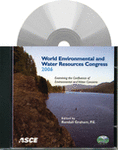Flow Energy, Time, and Evolution of Dynamic Fluvial Systems: Implications for Stabilization and Restoration of Unstable Systems
Publication: World Environmental and Water Resource Congress 2006: Examining the Confluence of Environmental and Water Concerns
Abstract
Alluvial streams are open systems which dynamically adjust to variations in flow energy and sediment supply. This balance can be referred to as dynamic equilibrium and implies that alluvial streams adjust their morphology in a variety of ways as a function of the imbalance between available force and upstream sediment delivery, and boundary resistance to hydraulic and geotechnical forces. Thus, two channels of similar morphology disturbed by an identical perturbation can attain very different equilibrium morphologies. Similarly, diverse alluvial systems disturbed by different perturbations can adjust in a similar manner manifest in cross section or reach morphologies. Both of these scenarios, although apparently divergent, can be explained in terms of non-linear reductions of stream power and flow energy with time and associated resistance of the boundary materials to streambed erosion by hydraulic forces and channel widening by mass failures. The common thread provided by analysis of flow energy is applicable in stream restoration practice because the physics of flow energy, sediment transport and mass failure do not vary by stream type or by region. Research into how disturbed fluvial systems respond to large perturbations was conducted using field-based analyses and numerical modeling of channel processes. Time-series cross sections from the Toutle River System over a 10-year period following the 1980 eruptions of Mount St. Helens and a 20-year period for alluvial streams of West Tennessee following channelization were analyzed in the context of adjustments in stream power and flow energy. Numerical simulations of sand-bed channels with banks of varying cohesive strengths and disturbed by cutting off half of the upstream sediment supply showed diverse morphologic adjustment that could be explained by boundary resistance and non-linear reductions in flow energy with time. Results provide a unifying means to understand how similar disturbances result in different morphologies and how different disturbances can result in similar morphologies. These are central issues in channel response and consequently, to design of stream restoration projects, particularly for those practitioners operating from a form-based perspective.
Get full access to this chapter
View all available purchase options and get full access to this chapter.
Information & Authors
Information
Published In
Copyright
© 2006 American Society of Civil Engineers.
History
Published online: Apr 26, 2012
ASCE Technical Topics:
- Channels (waterway)
- Ecological restoration
- Ecosystems
- Energy infrastructure
- Engineering fundamentals
- Environmental engineering
- Flow (fluid dynamics)
- Flow duration
- Fluid dynamics
- Fluid mechanics
- Hydraulic engineering
- Hydraulic structures
- Hydrologic engineering
- Infrastructure
- Lifeline systems
- Models (by type)
- Numerical models
- River engineering
- Rivers and streams
- Stream channels
- Water and water resources
- Waterways
Authors
Metrics & Citations
Metrics
Citations
Download citation
If you have the appropriate software installed, you can download article citation data to the citation manager of your choice. Simply select your manager software from the list below and click Download.
